Starbucks Lavender Powder Ingredients and the Benefits of Buying Real Farm Made Lavender Syrup!

Starbucks recently launched its spring menu and we weren’t surprised to see a heavy focus on lavender-based drinks using their proprietary Starbucks lavender powder ingredients.
We’re on the cusp of launching our first culinary lavender products at McKinley Lavender Farm. Two of the most requested items that our customers have been begging for us to bring to market, have finally made it back from the lab. They each passed the rigorous testing required in Canada to launch a food-based product with shelf stability.
The two lavender-based recipes are ones we’ve been loving for years around home. The first is our Orginal Lavender Simple Syrup and the second is our Lavender Lemonade Syrup. As we get ready to send these out into the world for more feedback, I thought looking at other lavender flavourings would be interesting. More importantly, I wanted to compare the ingredients list with ours. The results left me unsurprised and slightly annoyed.
Keep reading to learn more about my experience with various food-grade lavender syrups and powders for sale to consumers today:
None of the lavender drink products listed below contain real lavender.
For the record, I have tried all of the lavender products listed below – and then some. The most surprising thing about all of them is not so much what has been added to them but what was missing. Lavender. None of the “lavender” products below include actual, real lavender from the plant.
Many use a combination of Natural Lavender Flavours, or Natural Flavours and various synthetic and vegetable dyes to produce their lavender products. The products that use Natural Lavender Flavours, do not specify what kind of lavender is used. They also fail to communicate how the lavender is processed. Not to mention, the lavender’s origin, or any other details regarding the derivation of natural lavender flavor.
Which species and variety of lavender do people use for culinary purposes?
This is perhaps the biggest factor when you’re choosing a culinary-grade lavender syrup or edible product. Did you know that there are over 45 different lavender species and 450 varieties?
There is a massive difference in how each lavender tastes, smells, and cooks. To make a point, there are over 5000 varieties of potatoes. I think we can agree that Yellow, Russet, and Red potatoes all taste and cook differently compared to each other. Can you imagine serving a Sweet Potato to someone expecting a Russet?
This is also true of French (Lavandula x intermedia) vs English (Lavandula x Angustifolia) lavender species and their varieties. As should be expected, different varieties of lavender also have different tastes! In our experiments over the years, we have found that there are two varieties of lavender that we grow on our farm, that taste the best when it comes to food. In fact, the two that we grow for use in these products have been described as the pinnacle of culinary lavender in the world from chefs and culinary tastemakers.
“Natural Lavender Flavours”
That’s why I’m left scratching my head over ingredients that are described as “natural lavender flavours”. With so many varieties and species of lavender, I would really like to know exactly what variety I am ingesting. Especially, when we go back to that Potato example. The stems, leaves, and green parts of potatoes are toxic. They contain solanine, a toxic alkaloid that can cause gastrointestinal symptoms if ingested in large amounts.
There aren’t any concerns about other parts of the lavender plant being toxic or poisonous, however, knowing what variety you’re ingesting may help with allergies. We know there are many of you out there who have allergies to lavender. Perhaps the variety or species is the reason, or perhaps it’s more related to our next point – how we process lavender for use in a drink.
How do we process the lavender for use in a drink?
We grow and harvest our lavender right here on our farm in Kelowna, BC. We also know when and how we store our lavender before use. In addition to that level of ingredient transparency, we can also share that we use fresh and dried buds that have been stripped from the stems of our flagship culinary lavender plants.
We turn the lavender into syrup over the course of 24 hours and there are some very interesting things to note about how the process affects everything when working with lavender in the kitchen. From colour to taste there’s a lot to consider if you’re interested in natural products free from pesticides, chemicals, and additives.
We have experimented with whole lavender stems, fresh, and dried. We’ve also boiled it, distilled it, and used a spice grinder to make a lavender powder. Cold pressing, distilling, and baking – if there’s a way to use lavender we’ve tried it.
How you make it is just as important as what you make it with!
Why does it matter how you process the lavender? Let’s go back to our potato. Mashed vs French Fry? French Fry vs Baked? Baked vs Scalloped? They’re all very different methods of cooking potatoes that results in a completely different taste and end result.
The same is true of lavender in the kitchen. Using a finely ground lavender powder vs fresh/dried whole lavender buds is going to produce an entirely different taste, colour, and result. Especially when cultivators specifically cultivate those lavender buds for culinary use.
Where does the lavender originate from and why is that important?
Knowing where your lavender comes from is another check if you care about quality, safety, traceability, ethics, and above all supporting local farmers and growers. There aren’t as many checks and measures in farming and food cultivation as there are here in North America. Understanding the origin and quality of the lavender you use in the kitchen ensures that you are getting a safe, flavorful, and ethically sourced ingredient for your culinary creations.
There’s a noticeable quality difference between the buds and bundles that we sell and what is ordered from Amazon.
Does lavender syrup have a color?
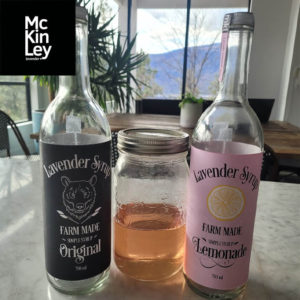
The short answer is, yes. But, not the colour you would expect, or the colour in any of the products readily available in the drink market today. The majority of lavender-based drink products use vegetable and synthetic dyes to achieve a deep purple colour. Natural lavender on it’s own has almost no colour to a very faint mauve. When mixed with other ingredients it will produce a very faint pink colour like our natural lavender lemonade simple syrup.
Boiling lavender with sugar and water yields very little to almost no colour after removing the plant material. When you grind dried lavender buds into a powder, you will achieve more of a purple colour, but you will be left with a gritty texture in your drinks.
For some reason, manufacturers disappointingly use everything and anything they can to achieve that deep purple color, despite lavender’s natural color. Unfortunately, these colour additives affect the taste, and in some cases may even affect your health.
Let’s take a closer look at the lavender drinks like Starbucks lavender powder ingredients and other flavours that you have likely encountered while trying to buy lavender syrup.
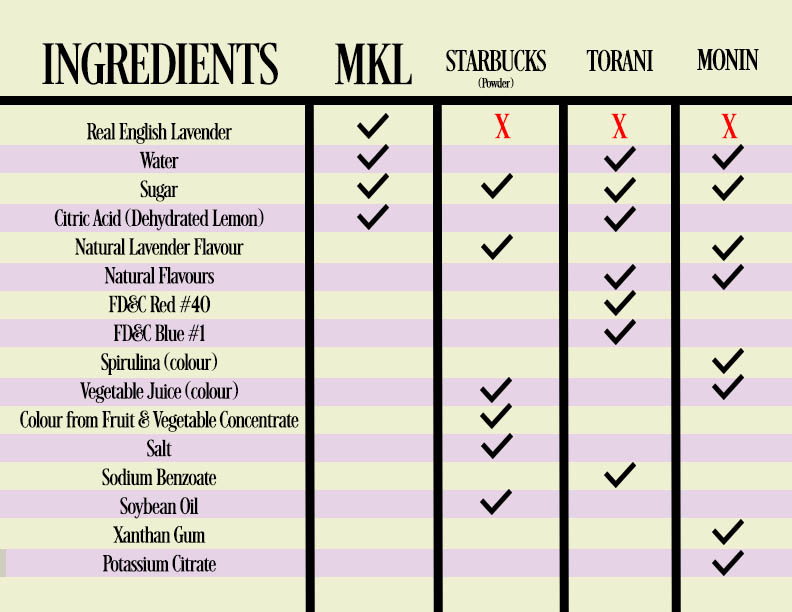
While these ingredients are generally safe for consumption, it’s important to consider individual dietary needs, preferences, and any potential allergies or sensitivities.
STARBUCKS – Lavender Powder Ingredients List:
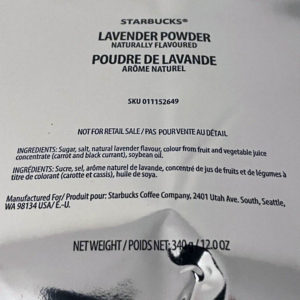
Sugar, Salt, Natural Lavender Flavour, Colour from Fruit and Vegetable Juice Concentrate (Carrot& Black Currant), Soybean Oil
Unnecessary additives in the STARBUCKS Lavender Powder:
Soybean Oil – Pro-inflammatory properties. Soybean oil has a high concentration of omega-6 fats. Overeating of it might stoke inflammation.
Salt – Most of the sodium in our diet comes from salt that has been added to the food we eat. Too much salt increases the risk of high blood pressure, heart disease, and stroke.
Torani – Lavender Syrup Ingredients List:
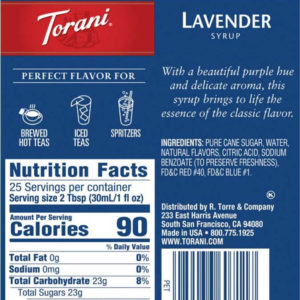
Pure Cane Sugar, Water, Natural Flavours, Citric Acid, Sodium Benzoate (to preserve freshness), FD&C Red #40, FD&C Blue #1
Unnecessary additives in the Monin Lavender Syrup:
FD&C Red #40 – Made from petroleum. some studies have linked artificial food dyes like red dye 40 to hyperactivity, including ADHD
FD&C Blue #1 – a synthetic dye produced from petroleum. potential to cause allergic reactions, including skin rashes, hives, or nasal congestion in sensitive individuals
Sodium Benzoate – When sodium benzoate is exposed to heat and light, it can react with certain substances to form benzene, a known carcinogen.
Monin – Lavender Syrup Ingredients List:
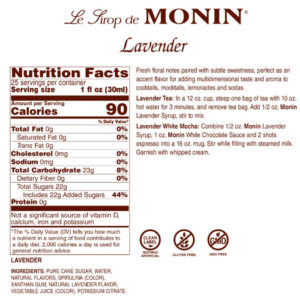
Pure Cane Sugar, Water, Natural Flavours, Spirulina (Colour), Xanthan Gum, Natural Lavender Flavour, Vegetable Juice (Colour), Potassium Citrate
Xanthan Gum
Unnecessary additives in the Monin Lavender Syrup:
Xanthan Gum – An additive used as a thickener, stabilizer, and emulsifier, xanthan gum is made when strains of the Xanthomonas Campestris bacteria are fed a solution of glucose that’s been derived from corn, soy, dairy, or wheat.
Here’s a breakdown of the additives in these lavender drink-making products.
The level of concern regarding food additives depends on various factors, including their individual safety profiles, regulatory approval, and potential health effects.
Artificial Food Colorings (FD&C Red #40, FD&C Blue #1)
These additives have raised some concerns due to potential links to allergic reactions, hyperactivity in children, and even possible carcinogenic effects. Regulatory bodies such as the FDA have approved their use in certain quantities. Still, some consumers prefer to avoid them due to these concerns.
Preservatives (Sodium Benzoate)
Sodium benzoate, used to preserve freshness, can potentially form benzene under certain conditions, which is a known carcinogen. However, high heat and acidic conditions primarily associate the risk. Regulatory bodies regulate its use, but some people prefer to minimize their intake of preservatives.
Natural Flavours
While generally considered safe, “natural flavors” can be a catch-all term for a variety of substances, some of which might not be desirable to certain consumers. Without specific information about the exact nature of the natural flavors used, it’s challenging to assess potential concerns.
Colorants from Fruit and Vegetable Juice Concentrates
People generally regard these as safer alternatives to artificial colorings. However, some individuals might have allergies to specific fruits or vegetables used in these concentrates.
Soybean Oil
Individuals with soy allergies need to exercise caution when consuming soy products. Soybean oil, while widely used and generally regarded as safe, can trigger allergic reactions in them.
While there may be some level of concern with certain additives, the overall risk depends on many factors. These include the specific additive, its concentration in the product, individual health considerations, and dietary preferences.
Some people may choose to avoid products containing certain additives, while others may not find them problematic. As always, moderation and balance in diet choices are essential for maintaining overall health and well-being.
Waitlist for real lavender syrup – wholesale and retail shoppers are all welcome!
In the case of these lavender products and ingredients, the main thing to consider isn’t what has been added, but what is missing. Lavender-based drinks that use powder and syrup that have been heavily dyed and have no trace of real lavender, aren’t it. Are you ready to try some real lavender syrup for your coffee, baking, and artisanal drinks? Stay tuned! We’re launching quickly, get on the waitlist by filling out the form below!
